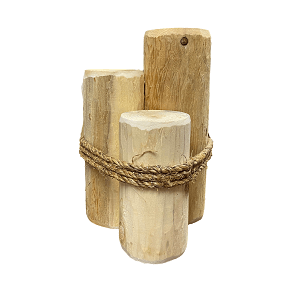Wood Piling Cost
Last Updated on September 14, 2023
Written by CPA Alec Pow | Content Reviewed by ![]() CFA Alexander Popinker
CFA Alexander Popinker
A common product in construction, which often has multiple uses and longer service life than steel, is the wooden pillar. Wood pillars are simply pillars, but their role differs from the pillars of a classic concrete structure. If in a classic masonry house, the pillars are placed on the surface, above the foundation, in the case of houses on pillars, the pillars have the role of replacing the foundation itself.
How Much Does Wood Piling Cost?
The wood piling cost will be affected by the type of construction and the labor involved. Expect to pay anywhere between $12 and $17 per linear foot, which means that for a 1,200 feet wood piling you will have to pay anywhere between $14,400 and $20,400.
Compared to other types of pilings such as concrete or metal, which cost anywhere between $45 and $80 per linear foot, wood piling is much more affordable and worth the cost thanks to its sustainability and durability.
In the tables below you will find the average costs of wood pilings by size and type of wood (untreated or treated).
| Size | Untreated wood | Treated wood |
| 14” | $19.75 | $24.95 |
| 14” | $24.25 | $29.90 |
| 12” | $16.00 | $20.55 |
| 10” | $12.50 | $16.40 |
Note: These price estimates include the pile and delivery costs. You will have to pay separately for the setup, and the costs will depend on the company you hire and the construction site.
You might also like our articles about the cost of the pier and beam foundations, steel I beam, or steel buildings.
Wood pilling overview
Wooden pillars are perhaps the oldest pillars used in the construction of houses. In terms of assembly, wooden pillar houses are perhaps the fastest to build. However, keep in mind that wood is subject to corrosion over time. Thus, the structures on wooden pillars do not necessarily represent a long-term investment, especially in areas where the groundwater is close to the surface.
You
Also, wood pilling has certain limits in terms of pressure. Often, they can withstand limited pressures, so they are strictly recommended for the construction of small cottages.
Types of wood pilings
 All the construction companies in the United States of America use three types of wood pilings that meet the construction and sustainability requirements.
All the construction companies in the United States of America use three types of wood pilings that meet the construction and sustainability requirements.
Barrel pilings are wooden pillars used mostly as columns in public and commercial constructions, parks, and zoos. In general, this type of piling is used in projects which require aesthetics and strength at the same time.
Square timber pilings are found in every type of building from beach homes to bridges. These are mostly used in piers and docks, pedestrian foundations, rails, and road bridges.
Round wood pilings are used mostly for the construction of docks, raised homes, piers, building foundations, railroads, and highways, thanks to their great compression and strength properties, and abundance.
Benefits of treated wood piling
This treatment can refer to an antifungal treatment, introduced deep into the wood fiber, with the help of an autoclave. Impregnation can be done with all kinds of chemicals. For example, there is creosote impregnation which is usually the treatment applied to wooden railway sleepers.
If you think that these pylons will rot in the ground, you should know that their lifespan in operation can be several centuries. Certainly, the building or structure on the surface will have a shorter life than the wood treated and inserted in the ground.
These products are available all over the country and can be accessed at decent prices.
Wood piling VS concrete piling: Treatments and coating
Left untreated or uncoated wood pillars will deteriorate over time. Both metal and wooden pillars are prone to corrosion. As you know, under the action of groundwater, wooden or metal poles can degrade relatively quickly.
To prevent these situations, materials should be inspected and treated regularly.
FAQs
Do wood pilings last longer than metal pilings?
Treated and coated wood pilings are more durable than metal pilings.
How much will it cost to pressure-treat my pilings?
The treatment cost will be affected by the amount of pressure you want to put on the timbers and the size of the timbers. You should expect to spend around $8 per cubic foot.
How can I coat my pilings for a longer service period?
There are various coating methods you can choose from such as painting, polymer coating, concrete coating, or even composite.
Conclusion
The amount of money you are going to spend on piling will vary from one location to another. Also, the costs will be higher for the above water constructions than those on land. The costs will be lower for the plain surfaces as well because there will not be a need for a lot of land preparation.
Other factors that will affect the costs are the size and the type of piling timber. It is recommended to contact a contractor or engineer to give you an exact quote.


Leave a Reply
Want to join the discussion?Feel free to contribute!